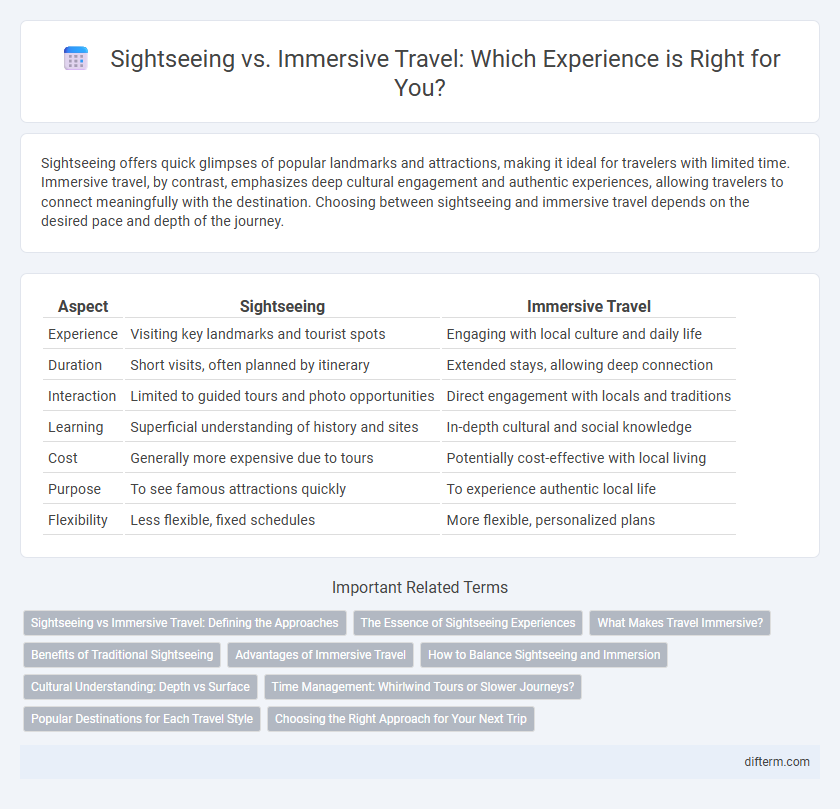Sightseeing offers quick glimpses of popular landmarks and attractions, making it ideal for travelers with limited time. Immersive travel, by contrast, emphasizes deep cultural engagement and authentic experiences, allowing travelers to connect meaningfully with the destination. Choosing between sightseeing and immersive travel depends on the desired pace and depth of the journey.
Table of Comparison
| Aspect | Sightseeing | Immersive Travel |
|---|---|---|
| Experience | Visiting key landmarks and tourist spots | Engaging with local culture and daily life |
| Duration | Short visits, often planned by itinerary | Extended stays, allowing deep connection |
| Interaction | Limited to guided tours and photo opportunities | Direct engagement with locals and traditions |
| Learning | Superficial understanding of history and sites | In-depth cultural and social knowledge |
| Cost | Generally more expensive due to tours | Potentially cost-effective with local living |
| Purpose | To see famous attractions quickly | To experience authentic local life |
| Flexibility | Less flexible, fixed schedules | More flexible, personalized plans |
Sightseeing vs Immersive Travel: Defining the Approaches
Sightseeing emphasizes visiting popular landmarks and iconic attractions, offering a broad overview of a destination's highlights within a limited timeframe. Immersive travel prioritizes deep cultural engagement, encouraging longer stays that facilitate authentic experiences, local interactions, and greater understanding of the community's heritage. This approach transforms travel into a meaningful journey beyond surface-level observation, fostering personal growth and cultural appreciation.
The Essence of Sightseeing Experiences
Sightseeing captures iconic landmarks and vibrant cityscapes that define a destination's visual appeal, offering travelers snapshots of cultural heritage and historical significance. Immersive travel delves deeper by engaging with local traditions, tastes, and everyday life, transforming passive observation into meaningful connection. Balancing both approaches enables a richer understanding of a destination's unique essence and authentic atmosphere.
What Makes Travel Immersive?
Immersive travel engages all senses by encouraging deep cultural connections, local interactions, and hands-on experiences that go beyond traditional sightseeing. It involves participating in daily life, tasting authentic cuisine, learning local customs, and understanding historical contexts from community perspectives. This approach transforms travel into a meaningful journey that fosters empathy and lasting memories.
Benefits of Traditional Sightseeing
Traditional sightseeing offers clear benefits such as efficient exploration of iconic landmarks, allowing travelers to maximize time and capture essential experiences in limited schedules. Guided tours provide structured itineraries that ensure visitors don't miss key historical and cultural highlights, enhancing overall understanding. This familiar approach often includes convenient access to popular attractions, transportation, and expert commentary, making it ideal for first-time or short-term travelers.
Advantages of Immersive Travel
Immersive travel offers deeper cultural engagement by allowing travelers to experience local traditions, cuisine, and daily life firsthand, fostering meaningful connections with communities. This approach enhances personal growth, empathy, and authentic understanding beyond surface-level observations typical of sightseeing. Immersive travel also supports sustainable tourism by promoting responsible interactions and benefiting local economies more directly.
How to Balance Sightseeing and Immersion
Balancing sightseeing and immersive travel involves allocating time to explore iconic landmarks while engaging deeply with local culture, traditions, and daily life to foster genuine connections. Prioritizing quality over quantity by selecting a few key sights and dedicating remaining time to interactive experiences such as cooking classes, community tours, or language practice enhances cultural understanding. Utilizing travel itineraries that alternate between structured tours and free-form exploration maximizes both memorable landmarks and authentic cultural immersion.
Cultural Understanding: Depth vs Surface
Sightseeing offers a surface-level experience focused on iconic landmarks and photo opportunities, often missing the deeper cultural context of a destination. Immersive travel prioritizes engaging with local customs, traditions, and everyday life, fostering genuine cultural understanding and meaningful connections. This approach transforms travel into a learning experience that enriches perspectives beyond visual appreciation.
Time Management: Whirlwind Tours or Slower Journeys?
Whirlwind tours maximize sightseeing by covering multiple landmarks in tight schedules, appealing to travelers with limited time but risking superficial experiences. Slower journeys prioritize immersive travel, allowing deeper cultural engagement and meaningful interactions through extended stays in fewer locations. Effective time management depends on traveler goals, balancing the desire for breadth versus depth in exploring destinations.
Popular Destinations for Each Travel Style
Popular sightseeing destinations include iconic landmarks such as the Eiffel Tower in Paris, the Great Wall of China, and the Colosseum in Rome, attracting millions of tourists annually. Immersive travel hotspots like Kyoto, Japan, and Bali, Indonesia offer cultural experiences through local cuisine, traditional arts, and community interactions. Each travel style appeals to different preferences, with sightseeing focusing on well-known attractions and immersive travel emphasizing authentic cultural engagement.
Choosing the Right Approach for Your Next Trip
Sightseeing offers a curated experience of iconic landmarks and popular attractions, ideal for travelers seeking quick highlights and photo opportunities. Immersive travel emphasizes deep cultural engagement, local interactions, and authentic experiences that foster meaningful connections and lasting memories. Selecting the right approach depends on personal interests, trip duration, and desired level of cultural involvement to maximize fulfillment and enjoyment.
sightseeing vs immersive travel Infographic

 difterm.com
difterm.com